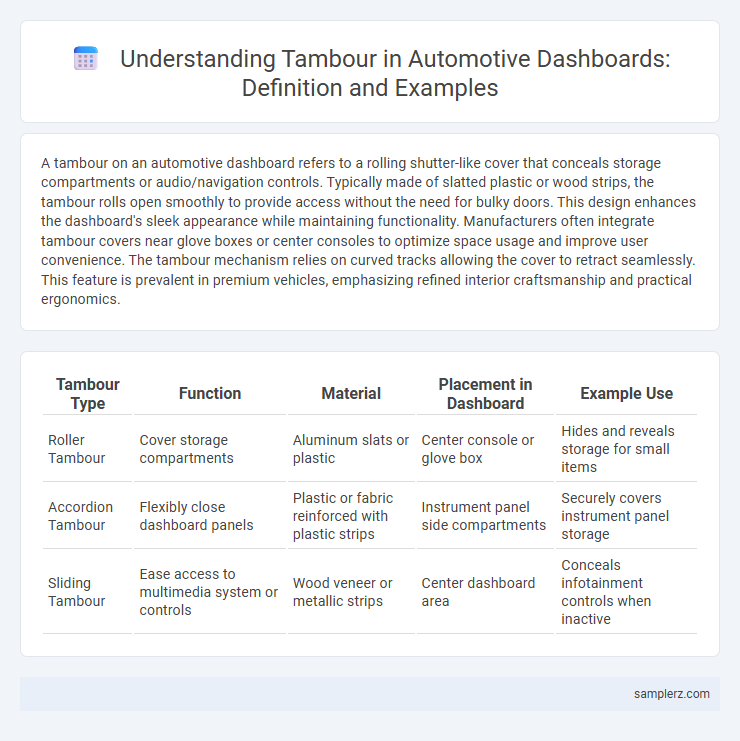A tambour on an automotive dashboard refers to a rolling shutter-like cover that conceals storage compartments or audio/navigation controls. Typically made of slatted plastic or wood strips, the tambour rolls open smoothly to provide access without the need for bulky doors. This design enhances the dashboard's sleek appearance while maintaining functionality. Manufacturers often integrate tambour covers near glove boxes or center consoles to optimize space usage and improve user convenience. The tambour mechanism relies on curved tracks allowing the cover to retract seamlessly. This feature is prevalent in premium vehicles, emphasizing refined interior craftsmanship and practical ergonomics.
Table of Comparison
| Tambour Type | Function | Material | Placement in Dashboard | Example Use |
|---|---|---|---|---|
| Roller Tambour | Cover storage compartments | Aluminum slats or plastic | Center console or glove box | Hides and reveals storage for small items |
| Accordion Tambour | Flexibly close dashboard panels | Plastic or fabric reinforced with plastic strips | Instrument panel side compartments | Securely covers instrument panel storage |
| Sliding Tambour | Ease access to multimedia system or controls | Wood veneer or metallic strips | Center dashboard area | Conceals infotainment controls when inactive |
Introduction to Tambour Doors in Automotive Dashboards
Tambour doors in automotive dashboards are flexible panels that slide horizontally or vertically to provide access to storage compartments, enhancing both functionality and design. Constructed from interconnected slats or flexible materials, tambour doors offer smooth operation in tight spaces where traditional hinged doors might be impractical. Their integration improves dashboard ergonomics and complements modern automotive interior aesthetics, making them a popular choice in luxury and utility vehicles.
Key Functions of Tambour Mechanisms in Car Interiors
Tambour mechanisms in automotive dashboards provide smooth, space-saving access to storage compartments by sliding curved slats along tracks, enhancing ergonomic functionality. These components enable secure closure and easy maneuverability, minimizing noise and vibration during vehicle operation. Their integration supports aesthetic design flexibility while maximizing interior space utilization in modern car interiors.
Popular Car Models Featuring Dashboard Tambours
Popular car models featuring dashboard tambours include the Mercedes-Benz S-Class, which uses tambour-style sliding panels for its infotainment controls, and the Tesla Model S, where tambour compartments offer seamless storage access. The Audi A8 integrates tambour doors within the center console, enhancing both aesthetics and functionality. These tambour dashboard designs provide smooth operation and contribute to a modern, clutter-free interior environment.
Materials Commonly Used in Dashboard Tambour Construction
Dashboard tambours in automotive design commonly utilize materials such as flexible wood veneers, aluminum slats, and high-quality plastics to achieve both aesthetic appeal and durability. Wood veneers offer a natural, luxurious finish, while aluminum slats provide lightweight strength and resistance to corrosion. High-quality plastics, often reinforced with fiberglass or other composites, contribute to flexibility and ease of manufacturing, ensuring smooth operation and longevity in tambour mechanisms.
Design Trends: Modern Vs Classic Tambour Styles
Modern tambour styles in automotive dashboards emphasize sleek, linear patterns with high-gloss or matte finishes, using premium materials like carbon fiber and aluminum to enhance a futuristic aesthetic. Classic tambour designs often feature wooden slats or textured metals arranged in rounded, horizontal patterns, evoking a vintage, elegant feel reminiscent of mid-century automobiles. The shift from traditional curved slats to minimalist, flat-panel tambours reflects broader design trends prioritizing both functionality and streamlined aesthetics in contemporary vehicle interiors.
Advantages of Tambour Compartments in Dashboards
Tambour compartments in automotive dashboards offer seamless integration with the vehicle's interior design, providing smooth, space-saving storage solutions that enhance cabin organization. Their flexible slatted design allows for easy opening and closing without protruding handles, improving driver safety by minimizing distractions. Durable materials and precision engineering ensure longevity and resistance to wear, contributing to a premium and functional dashboard experience.
How Tambour Doors Enhance Dashboard Aesthetics
Tambour doors integrate seamlessly into automotive dashboards, offering a sleek, continuous surface that enhances interior design sophistication. Their rolling mechanism saves space while providing easy access to storage compartments, contributing to a clean, clutter-free cabin environment. High-quality materials like aluminum or textured polymers used in tambour doors also improve tactile and visual appeal, elevating overall dashboard aesthetics.
Maintenance Tips for Automotive Dashboard Tambours
Automotive dashboard tambours, commonly used for smoothly sliding covers over storage compartments or controls, require regular maintenance to ensure optimal functionality. Applying a silicone-based lubricant to the tambour tracks prevents sticking and wear without attracting dust. Regular cleaning with a soft cloth and mild detergent removes debris that can hinder movement and prolongs the lifespan of the dashboard components.
Integration of Tambour Storage with Infotainment Systems
The integration of tambour storage in automotive dashboards enhances both functionality and design by providing concealed compartments that seamlessly complement infotainment systems. These tambour panels enable easy access to electronic controls and devices while maintaining a clean, organized dashboard appearance. Advanced materials and precision engineering ensure tambour mechanisms operate smoothly, supporting the connectivity and usability of infotainment displays and controls.
Future Innovations in Tambour Applications for Vehicles
Future innovations in tambour systems for vehicle dashboards emphasize lightweight, flexible materials integrated with smart sensors for enhanced user interaction and safety. Advanced tambour designs incorporate OLED displays and touch-sensitive surfaces, enabling customizable and seamless dashboard interfaces. These developments improve both aesthetic appeal and functional responsiveness, aligning with the automotive industry's shift towards intelligent, connected vehicles.

example of tambour in dashboard Infographic
 samplerz.com
samplerz.com